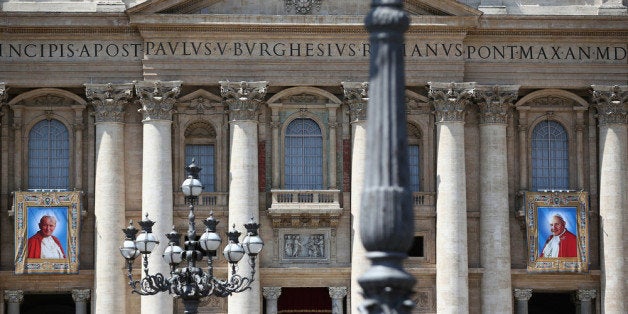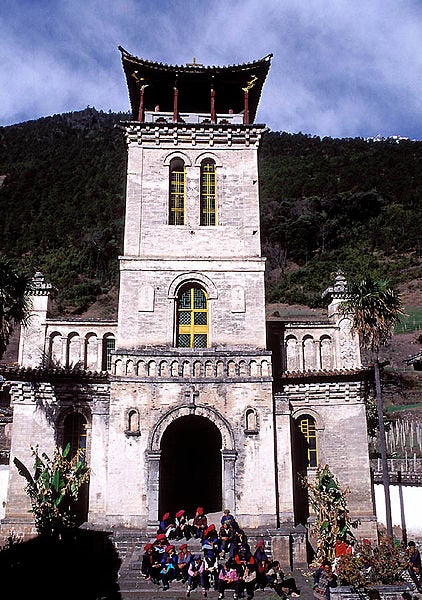
By Tom Heneghan, Religion Editor
April 25 (Reuters) - When the late Popes John XXIII and John Paul II are declared saints on Sunday, the Vatican ceremony will be both a spiritual event for Roman Catholicism and a lesson in the subtle politics of the world's largest church.
Most of the world's 1.2 billion Catholics will generally agree that these two men, in their own ways, were holy and charismatic pastors who helped their 2,000-year-old Church to confront the challenges of the modern era.
When it comes to details, though, opinions will diverge. The debates are long and complex, but the popular notion of John as a liberal champion and John Paul as a conservative stalwart gives a rough outline of how they are seen.
As such, they symbolise two groups in the Catholic Church that have disagreed for decades, sometimes bitterly, over how to interpret the results of the reforming Second Vatican Council of 1962-1965 that John launched and John Paul largely implemented.
By canonising both, Argentine-born Pope Francis will be using the symbolism of unity to urge Catholics to look beyond these divisions to join together in following the Gospel.
"These two popes represent different wings of the Church," said Ashley McGuire of the Catholic Association, a Washington-based lay group that defends Catholic views on public issues.
"Unity is a big theme of Pope Francis's papacy. He's saying we're all Catholics, we're on a common journey together."
UNITY AND DIVERSITY
While popes symbolise the unity of the Church, each one has his own priorities. Some are put into words in sermons and encyclicals, others into deeds in appointments of bishops and cardinals or choices of candidates to declare as saints.
"Canonising popes can be politically divisive in the Church when it is an attempt by one faction to impose its model of the papacy on the future by bolstering the legacy of its favourite pope," Rev. Thomas Reese, a prolific U.S. Jesuit analyst of Vatican affairs, commented on the canonisations.
"Francis's solution is brilliant ... since the men are so different, it does not canonise either model of being pope. It leaves him free to follow his own path."
John, who was born in Italy in 1881 and reigned from 1958 to 1963, is best remembered for convening the Council and promoting "aggiornamento" (updating) to open the Church to modern times.
He died after the first of the Council's four sessions and did not witness its far-reaching changes - including the end of Latin at Mass, use of modern music and challenges to Vatican authority - that appealed to reformers but alienated those more at home with the traditional ways.
Polish-born John Paul, pope from 1978 to 2005, upheld many Council reforms, but shifted the emphasis towards a more centralised Church, with clearer condemnations of wayward theologians and sexual freedom and a more assertive expression of Catholic identity in a strongly secularised world.
That more conservative turn was amplified by his German successor Benedict XVI, pope from 2005 to 2013, who brought back an older liturgical style and readmitted ultra-traditionalists who reject the Council and were excommunicated by John Paul.
In addition to debates over the Council, the scandal of clerical sexual abuse of children hangs over the last two pontificates, creating additional fault lines within the Church.
TWINNING POPES
Twinning papal candidates for sainthood has developed in recent decades as canonisations, which once were less frequent and less visible to the world's Catholics, have become events immediately broadcast around the globe.
"It goes back to Pope Paul VI," said church historian Massimo Faggioli, author of the new book John XXIII: The Medicine of Mercy, referring to the pontiff from 1963 to 1978.
In 1963, following John's death, several cardinals asked his successor if the Vatican Council could declare the late pope a saint by acclamation, as was the custom in the early Church.
Paul cautiously waited until the Council's end in 1965 and then started the procedures for beatification - the step before sainthood - for John and his conservative predecessor Pius XII.
Pius's case bogged down in controversy over his role during the Holocaust, when critics said he ignored the fate of the Jews while defenders said he did all he could to save them.
When in 2000 John Paul beatified John, he twinned him with Pius IX, the pope who convened the First Vatican Council in 1869-1870 but whose long papacy (1846-1878) was marred by reactionary politics and accusations of anti-Semitism.
Pope Benedict put John Paul on the fast-track to beatification and canonisation and had Pius XII declared "venerable," the step before beatification - two acts seen as underlining the conservative emphasis of his pontificate.
"In 2010-2011, the rumour in Rome was that the couple (to be canonised) under Pope Benedict would be John Paul and Pius," said Faggioli. (Reporting By Tom Heneghan; Editing by Louise Ireland)

